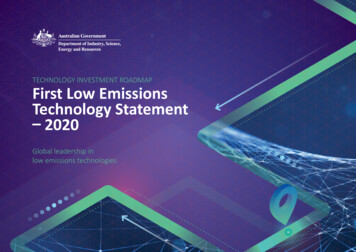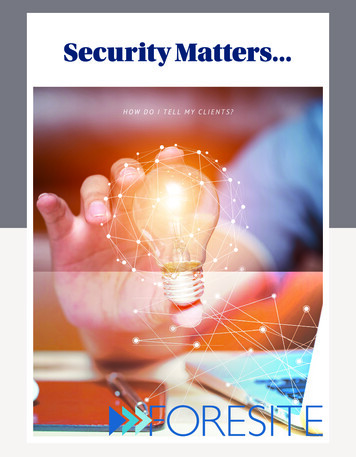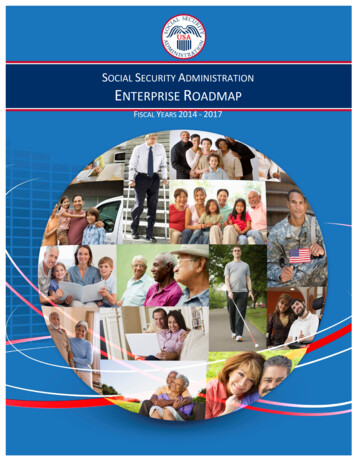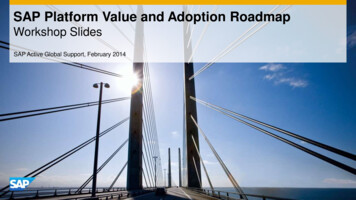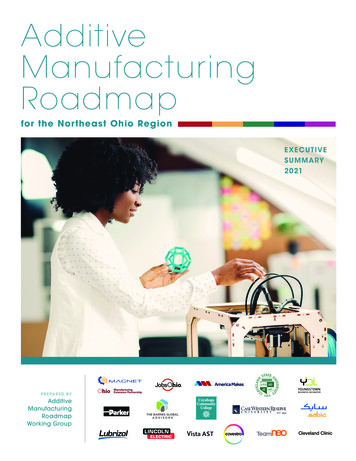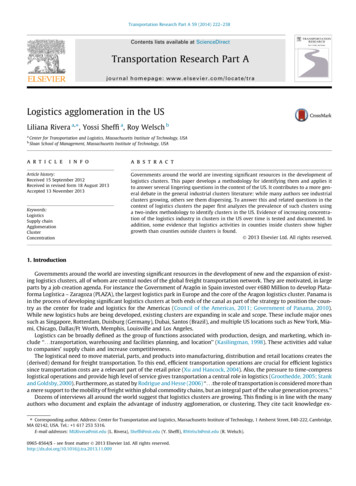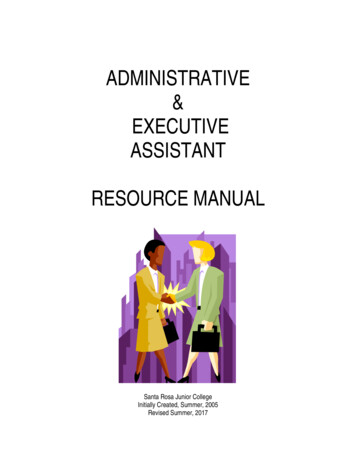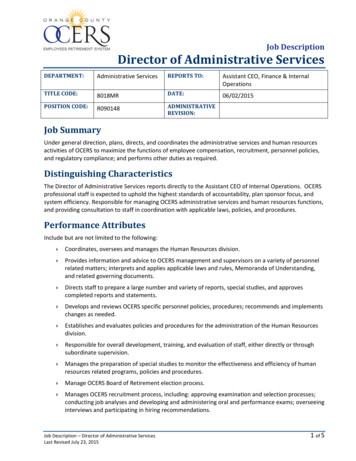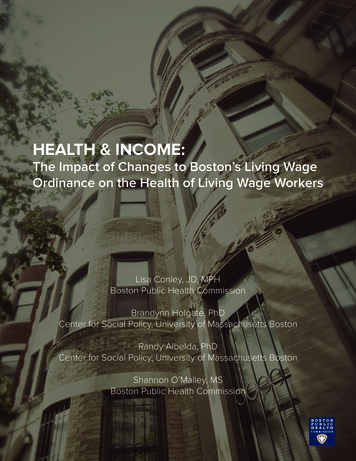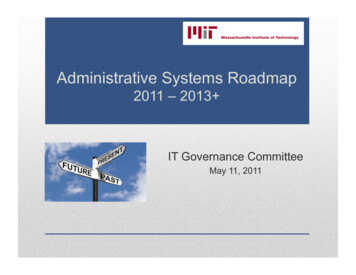
Transcription
Administrative Systems Roadmap2011 – 2013 IT Governance CommitteeMay 11, 2011
Administrative Systems, in partnership with ourcustomers, is charged with providing enterpriseadministrative business systems that make it easy forthe MIT community to do its work.Our vision is to provide an administrative businesssystem worthy of MIT, achieved by implementing highimpact, customer-facing functionality with anenhanced user experience, on an extensible,maintainable, standard technical and infrastructureplatform.Introduction2
The administrative systems roadmap is a 3-year plan to advancethe goal of an administrative business system worthy of MIT inthe 21st century by: Adding new services and business functionalityEnhancing the user experienceAssuring long-term sustainability and reliabilityReducing the time to delivery and cost of maintenanceThe Administrative Systems roadmap includes recent-year effortsto gather business and technology direction, including: Institute-wide Planning Task ForceAdministrative Systems Policy and Coordinating Council (ASPCC)Business offices vision and system needsSAP functional, technology, and landscape assessmentsSetting a technology strategy for the technology roadmapASPCC Executive SessionsApproach3
StandardizationWe will limit customization to only what is absolutely necessary. We will embrace the 80/20 rule.SustainabilityOur solutions should look toward the future, adhere to technology standards, be highly configurable and flexible systems to adapt tochanges in policy and practices, and require as little ongoing maintenance as possible.ExtensibilityWe will deliver templates and standard solutions where possible that are capable of being extended broadly for similar needs.IntegrationWe will consider the effects of our decisions on other components and modules that are in use or planned for use at MIT.UsabilityWe will develop a model that will enhance the user experience and help the MIT community conduct its business as easily aspossible.Best PracticesWe will adopt best practices in our process improvement and data management wherever possible.Use Existing Solution CapabilitiesWe will shorten time to solution delivery and lower total cost of ownership.Strong Internal ControlsWe shall deliver systems that are capable of meeting the organization's objectives for protecting and ensuring reliability of processes,data and systems.Guiding Principles4
Digital evolution in MIT (Digital MIT)Create efficiencies in business processes by replacing paper with automation and online self service and workflow, where beneficialand appropriate, to modernize, meet community expectations, and reduce environmental impact.Intuitive User ExperienceProvide a consistent, coherent, unified, customer-centric view between and among processes and information toprovide system integration efficiencies and support a seamless, intuitive user experience.Simplify Business ProcessesStreamline practices where meaningful to reduce inefficiencies and handoffs, and allow for simpler user-to-system interactions.De-customizationUse standard structure and components for new and replacement software to lay a foundation for system sustainability, reducetechnology risk, permit extensibility, and enable more efficient ongoing operational support.Legal / Regulatory ComplianceApply necessary changes to ensure compliance with all legal and regulatory mandates.Improved Reporting & AnalyticsProvide data infrastructure, data management, and reporting tools to enable simplified, consistent, and efficient access toinformation.Strategic Objectives5
Intuitive userexperience Simplified businessprocesses Digital MIT Improved reportingand analyticsCommunityBusiness HR/Payroll Procure to Pay Financial EH&S Facilities Global Initiatives DocumentManagement Workflow User Gateway De-customization Data & Reporting (seeData Roadmap) Mobile Computing(see Mobile Roadmap) User SecurityFoundationalInfrastructure Web Development Batch Operations InfrastructureMonitoring Interfaces Landscape Testing &Documentation (seeQA Roadmap)TechnologyFoundational: The applications or components that apply broadly across the system or to multiple functional areas of administrative systems. Requirements are driven bythe business offices and end users, while the technology solutions are the responsibility of IS&T.Infrastructure: The back-end platforms and tools for developing and managing administrative systems. Requirements and solution decisions are the responsibility of IS&T.Tracks6
ProcessModernizationDigital MIT Modernize Paperless solutions Digitize De-customize Information on demandthrough electronic documentmanagement systems Create processes that aremore standard, but tailored tomeet customer needs Web-based platform forreporting and financialforecastingProcurement Wider adoption of electronicprocurement tools Electronic invoicing andreimbursement Vendor management system Streamline MIT’s budgetprocessBusiness VisionSource: Final Report, MIT Institute-wide Planning Task Force report, December 16, 20097
Work streamsDescription (partial list) Recognize and manage 3 distinct work streams Dedicate staff to specific work stream Broaden MIT expertise Augment MIT staff with external resources, including“exceptional experts”Day to DayOperations Run daily, weekly, yearly jobsRun interfaces in/out and addressexceptions ReconcileProduce reportsSystem backups & operationsMaintain servers, storagePerformance System monitoringFix things that don’t workProvide helpAnalyze problems Support &Enhancements Projects PrioritizeSupport packsOpen enrollmentEtc Pension, RFP 1.1, APR, Global, EL,Hourly Student Feed, Bundled releases of enhancements, 2 Year initiative to improve Day-to-Day Operations:o Clarify Roles & Responsibilitieso Improve/automate batch job schedulingo Improve/automate interfaceso Expand automated monitoring Establish on-going Day-to-Day operations supportstructure, appropriately skilled, with automated tools 1 Year initiative to reduce backlog to reasonable/target level Simplified support and enhancement resolutionprocess Establish on-going Support and Enhancement coreteam with responsibility and authority to effectivelymanage process Mandatory Prototyping Transition plan from projects to day to day support Plan project portfolio and resource allocationTransform operating model8
VPFQAQAHRVPFHRDaytoDayOperationsDevelopersSupport ilityProjectsDay to DayOperationsDataMgtR/3AdminTrainingTransform Operating ModelOther9
FY2011WebDevelopmentDisplay ReqprototypeFY2012Web appmigrationstrategySAPwebSSassessmentUser GatewayGatewayproof frastructureMonitoringMigrate jobs to new jobschedulerFY2013 Migrate to web apps to new development technologyMigrate to portalProcess change for scheduling batch jobsExtend use of standard ment attachmentdiscovery in APRMigrate to middlewareImplement environment / client strategyUpgradeExtend solution to other functional areasTransform Technology Foundation10
B&# .;(6@"7;1&)A"%9 (;'?! ( ) ) &9".(;'?!&:# 4("%; (;"'-&7)!&8&1"9%&'(* ##,(-%./0),!;4#"8&.6!&8&1"9%&'(!;4#"8&.634&.)5 (&2 6&'"()"#DCEG DCEDCEG LJGBLFBCDCEDCEDCEDC HB MDCEDCEG G E #;1;(;&4-"./01"2!"# %*C C&'4;"')F (4" .#;'?51"7 1)H';(; (;8&4!;?;( 1)E&&I4J'(&.9.;4&)K& .';'?!;?;( 1)B( (&%&'(4 ECC."# .&:(":C 6 &9".(;'?) )E".&# 4(;'?)M""1)N *EMOA"?'"4)NE. %&2"./) ) &9".(;'?O&!*AA*F.? '; (;"'4) &1 (;"'4,;94A"%9&'4 (;"')@ ' ?&%&'(C&.0".% '#&)@ ' ?&%&'(@"7;1&)I&8;#&4)0".) &9 ;.) 'I)@ ;'(&' '#&!"# %&'()*(( #,%&'(1,2/("3"45H%91&%&'( "()B( .(&IP"()B( .(&IP"()B( .(&IP"()B( .(&IBusiness Links to Technology11
Pension Recordkeeping OutsourcingRequest for Payment 1.1Enterprise LearningDigital Feeds - Hourly Student AppointmentsAppointment Process RedesignReporting and Forecasting Tool (RAFT)Global InitiativeVendor Management System PilotCognos Framework and ReportingCost Accounting for Institute BuildingsTechnology InitiativesProjects12
In summary We recognize current systems and service delivery model results ininsufficient progress for MITEvolve foundational, infrastructure, delivery model, and projects that meetMIT’s needsAdministrative solutions that exceed expectations, are delivered faster andmore efficientlyNext Steps Complete staffing model/plansDetermine which projects will go forward (6-12 months)Update roadmapReview and gain ASPCC approval for updated roadmapPresent revised roadmap to IT Governance CommitteeConclusion13
Appendix14
AreaCurrent StateVisionWebDevelopment Customized development.Multiple development technologies.Multiple skill sets required.Some technology out of support. User Gateway Multiple access points: SAPweb, SAPwebSelf Service, insideMIT portal, SAP portal.Outdated strategy unable to takeadvantage of new handheld devices. 1,650 batch daily jobs per day scheduled,event driven, or ad hoc.Batch jobs manually run in some areasDistributed ownership with inconsistentmonitoring.Lack of coordination managing batchprocessing loads on system.Limited documentation. BatchOperations InfrastructureMonitoring Multiple tools, distributed monitoring.Some manual monitoring.Limited application level monitoring. Adopt SAP strategy for user interface development (WebDynpro ABAP).Reduced delivery time for new functions, and skill setsrequired to develop and support web apps.Fewer access points, gateways, portals; more consistentcustomer-centric user experience.Updated technology.Limited customization.Centralized and streamlined batch job schedulingenvironment.Improved capabilities to schedule jobs at a businessprocess level and across system environments.Manage system loads from central place.Improved monitoring, audit, and reporting. Reliableservice to customers and partners.Central documentation repository with error & restartprocesses defined.Clear batch job ownership and escalation path.Consolidated and/or central monitoring.Automated recurring monitoring tasks. Ability to defineand track performance metrics.Timely responses to production outages and incidents.Proactive maintenance and administration.Complete documentation.Current and Future Technical States15
AreaCurrent StateVisionInterfaces 180 point-to-point, individually maintainedinterfaces in/out of SAP from both internalproviders (Data Warehouse, Coeus) andexternal (Bank of America, Fidelity,SciQuest).15-yr-old custom inbound (dropbox) andoutbound solutions; one dropbox expert.No dashboard functionality and no activemonitoring. Some restart procedures, alertsare manual. Some interfaces executedmanually.Limited documentation. Long refresh time delays projects; high Basiseffort.Significant staff effort.Multiple environments (8 instances with fullproduction data).Ad hoc refreshes.Custom scrambling programs.Limited documentation. Servers/Infrastructure(Landscape) Single, central repository to model, document, anddefine interfaces.High performance, security.Open standards for interoperability.Reliable service to customers and partners.Interface validation.Clear alerts to take the correct action in the rightcontext.Clear ownership and procedures.Ability to reroute feeds for testing.Landscape that applies industry best practices.Fewer, consistent environments with easier, quickerupkeep and refresh.Less manual maintenance effort.Shorter support pack project duration.Use of standard vendor data scrambling product.Clear documentation.DocumentManagementMultiple systems/applications for various levelsof document management: Paper, IXOS, Optix.Web-accessible, central document management systemas part of an enterprise-wide content managment systemthat offers security, storage, retrieval, viewing, workflow,approval, integration, and archiving of documents.Decustomization Some core functions highly customized,restricting ability to leverage newerfunctionality.Higher MIT support effort.Less customization.Use product capability.Leverage vendor support.Current and Future Technical States16
AreaCurrent StateVisionWorkflow Workflow is heterogeneous, using different technologies andplatforms and solutions.Largely non-hierarchical and manually maintained.Configurable workflow solution thatstreamlines and automates processes,and permits ad hoc approvers.Testing Central test repository.Some tests automated.See QA Roadmap.Data &ReportingSee Data Roadmap.See Data Roadmap.MobileComputingSee Mobile Roadmap.See Mobile Computing Roadmap.Security See Security Roadmap. Certificates on shared devices potentially expose confidentialinformation like paystubs, W2, 1099s.Challenges integrating MIT’s approach with 3rd partysolutions (ex. Concur, SAP portal, etc. with Touchstone,Roles, Kerberos, etc.).Granularity & complexity of data access control (field level,across systems).Reluctance to store certain data digitally or centrally becauseof security concerns (medical courses, animal care training,training on resume writing, etc.)Current and Future Technical States17
Migrate jobs to new job scheduler Extend use of standard tools Implement environment / client strategy Migrate to middleware Migrate to porta l Web app migration . solutions (ex. Concur, SAP portal, etc. with Touchstone, Roles, Kerberos, etc.). Granularity & complexity of data access control (field level, across systems).

